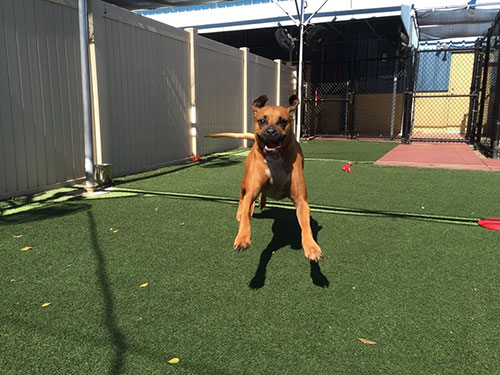While a few extra pounds can be uncomfortable on us humans, that extra weight on our dogs can be a big problem. National Pet Obesity Awareness Day is October 7. It’s a reminder to regularly check our pet’s weight to keep them happy and healthy. Maintaining a healthy weight in our pets helps us avoid the dangers of obesity-related injuries and diseases, like Type 2 Diabetes, excess strain on bones and organs, increased risk for heart and respiratory disease and multiple cancers.
Fortunately, there is plenty we can do to keep our dogs at healthy weights. The steps below outline measures you can take to prevent obesity in your dog.
Know your dogs’ ideal weight.
Did you know that an estimated 56% of dogs are overweight or obese? One of the primary causes of this is that many pet owners do not know the actual weight that their dog should be. At your dog’s next checkup, your vet will be able to advise you on your dog’s ideal weight. In the meantime, there are a few ways to measure whether your dog is under or overweight. You should not necessarily see ribs, but they should be easily felt with slight fat cover when running your hands over your dog’s sides. Looking at your dog from an overhead view, you should see a well-proportioned waist.
Know your dog’s dietary needs.
If your dog is overweight, the first place to start is the diet. Your goal is to adjust calorie intake. Most dog food brands have suggested serving sizes on the bags or cans. Use your dog’s ideal weight when measuring the food (not the weight he’s at right now). The guidelines on the food are a good starting point, but you can watch your dog’s behavior and adjust food amounts based on whether he is acting too hungry. Replace store-bought treats with crunchy, low-calorie vegetables like carrots, broccoli, celery and asparagus. Finally, if you’re in a multi-dog household, feed each dog in a separate room so that no one has a chance to steal bites out of another bowl.

Get out and get moving.
Depending on your dog’s age and breed, a walk around the block most likely isn’t enough exercise for his physical (and mental) health. If your dog needs to lose weight or maintain healthy weight, brisk powerwalking or running is the best option. You can also try at least 20 minutes of heart-pumping playtime in a fenced yard or dog park (just be sure to evaluate the other dogs in the park before entering for your and your dog’s safety). Your dog may snoop around while you sit on a bench, but he’ll get the exercise he needs if you’re up and moving with him. Try some rigorous games of fetch or play chase with him. Another great solution for daily exercise is doggy daycare. Playtime in daycare can cover all of your dog’s exercise needs while leaving him mentally stimulated and physically fit.
Monitor your dog’s weight.
Ease into weight loss by gradually increasing exercise and steadily improving your dog’s diet. Think about how frustrated you’d be if somebody suddenly reduced the amount of food you got while forcing you to do strenuous exercise your body couldn’t handle. Instead, make these healthy lifestyle adjustments fun for you and your dog by finding ways to build enjoyable activity into your schedule. As you see the weight coming off, you can increase the intensity of exercise. Monitor your dog’s body shape to be sure that these lifestyle changes are positively affecting his weight. If after a month you don’t see even a slight change, it’s time to add more exercise into your daily routine and reevaluate your dog’s diet.
Reach out to your vet.
If your dog is severely obese, it’s always safest to start at the vet so you can get your pet on the right track to health without causing him too much discomfort. Your veterinarian can also help determine if there are any ailments that are causing weight gain. At any point in the weight loss journey, you can talk to your vet if you have any questions about diet or exercise changes.
You may be surprised in the changes you see in your dog when he is at a healthy weight, with more energy and less agitation. Living an active lifestyle and maintaining your pet’s healthy weight is one of the most important things you can do you’re your dog’s happiness, wellbeing and longevity.

